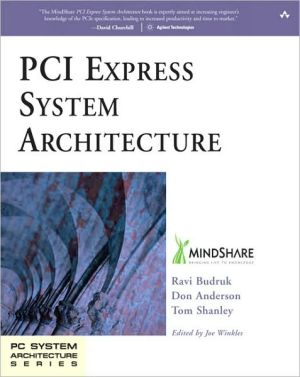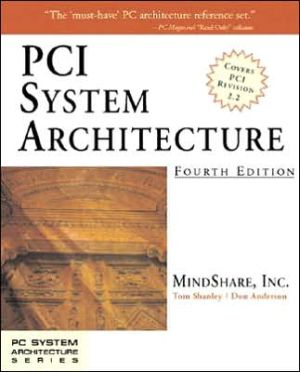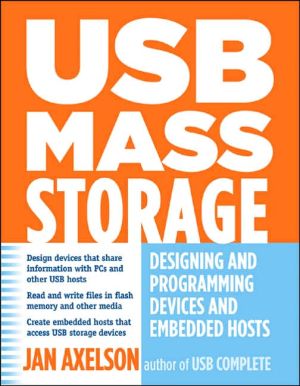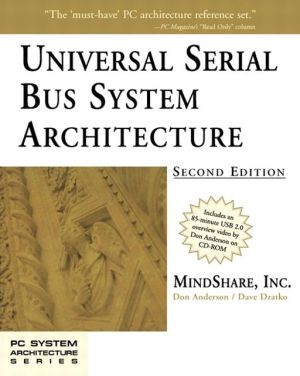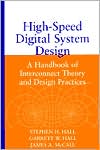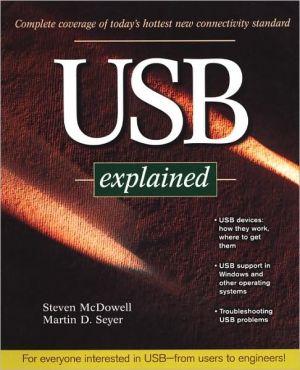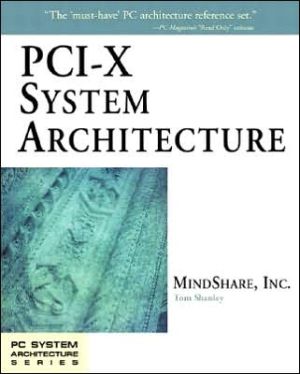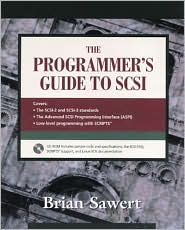PCI Express System Architecture
PCI Express is the third-generation Peripheral Component Interconnect technology for a wide range of systems and peripheral devices. Incorporating recent advances in high-speed, point-to-point interconnects, PCI Express provides significantly higher performance, reliability, and enhanced capabilities -- at a lower cost -- than the previous PCI and PCI-X standards. Therefore, anyone working on next-generation PC systems, BIOS and device driver development, and peripheral device design will...
Search in google:
"We have always recommended these books to our customers and even our own engineers for developing a better understanding of technologies and specifications. We find the latest PCI Express book from MindShare to have the same content and high quality as all the others."—Nader Saleh, CEO/President, Catalyst Enterprises, Inc.PCI Express is the third-generation Peripheral Component Inter-connect technology for a wide range of systems and peripheral devices. Incorporating recent advances in high-speed, point-to-point interconnects, PCI Express provides significantly higher performance, reliability, and enhanced capabilities—at a lower cost—than the previous PCI and PCI-X standards. Therefore, anyone working on next-generation PC systems, BIOS and device driver development, and peripheral device design will need to have a thorough understanding of PCI Express.PCI Express System Architecture provides an in-depth description and comprehensive reference to the PCI Express standard. The book contains information needed for design, verification, and test, as well as background information essential for writing low-level BIOS and device drivers. In addition, it offers valuable insight into the technology's evolution and cutting-edge features.Following an overview of the PCI Express architecture, the book moves on to cover transaction protocols, the physical/electrical layer, power management, configuration, and more. Specific topics covered include: Split transaction protocol Packet format and definition, including use of each field ACK/NAK protocol Traffic Class and Virtual Channel applications and use Flow control initialization and operation Error checking mechanisms and reporting options Switch design issues Advanced Power Management mechanisms and use Active State Link power management Hot Plug design and operation Message transactions Physical layer functions Electrical signaling characteristics and issues PCI Express enumeration procedures Configuration register definitionsThoughtfully organized, featuring a plethora of illustrations, and comprehensive in scope, PCI Express System Architecture is an essential resource for anyone working with this important technology.MindShare's PC System Architecture Series is a crisply written and comprehensive set of guides to the most important PC hardware standards. Books in the series are intended for use by hardware and software designers, programmers, and support personnel.
The MindShare Architecture Series\ The MindShare Architecture book series currently includes the books listed below. The entire book series is published by Addison-Wesley.\ \ Books about Processor Architecture: \ \ \ \ 80486 System Architecture, Third Edition, 0-201-40994-1\ Pentium Processor System Architecture, Second Edition, 0-201-40992-5\ \ \ \ \ Pentium Pro and Pentium II System Architecture, Second Edition, 0-201-30973-4\ \ \ \ \ Power PC System Architecture, 0-201-40990-9\ \ \ \ \ Books About Bus Architecture: \ \ \ \ PCI System Architecture, Fourth Edition, 0-201-30974-2\ \ \ \ \ PCI-X System Architecture, 0-201-72682-3\ \ \ \ \ EISA System Architecture, 0-201-40995-X—Out-of-print\ \ \ \ \ Firewire System Architecture, Second Edition: IEEE 1394a, 0-201-48535-4\ \ \ \ \ ISA System Architecture, Third Edition, 0-201-40996-8\ \ \ \ \ Universal Serial Bus System Architecture 2.0, 0-201-46137-4\ \ \ \ \ HyperTransport System Architecture, 0-321-16845-3\ \ \ \ \ PCI Express System Architecture, 0-321-15630-7\ \ \ \ \ Books About Network Architecture: \ \ \ \ Network Architecture Infiniband Network Architecture, 0-321-11765-4\ \ \ \ \ Books About Other Architectures: \ \ \ \ PCMCIA System Architecture, Second Edition: 16-Bit PC Cards, 0-201-40991-7\ \ \ \ \ CardBus System Architecture, 0-201-40997-6\ \ \ \ \ Plug and Play System Architecture, 0-201-41013-3\ \ \ \ \ Protected Mode Software Architecture, 0-201-55447-X\ \ \ \ \ AGP System Architecture, 0-201-37964-3\ \ \ \ \ \ Cautionary Note\ The reader should keep in mind that MindShare's book series often details rapidly evolving technologies, as is the case with PCI Express. This being the case, it should be recognized that the book is a "snapshot" of the state of the technology at the time the book was completed. We make every attempt to produce our books on a timely basis, but the next revision of the specification is not introduced in time to make necessary changes. This PCI Express book complies with revision 1.0a of the PCI Express Base Specification released and trademarked by the PCI Special Interest Group. Several expansion card form-factor specifications are planned for PCI Express, but only the Electro-mechanical specification, revision 1.0 was released when this book was completed. However, the chapter covering the Card Electromechanical topic reviews several form-factors that were under development at the time of writing.\ Intended Audience\ This book is intended for use by hardware and software design and support personnel. The tutorial approach taken may also make it useful to technical personnel not directly involved design, verification, and other support functions.\ Prerequisite Knowledge\ It is recommended that the reader has a reasonable background in PC architecture, including experience or knowledge of an I/O bus and related protocol. Because PCI Express maintains several levels of compatibility with the original PCI design, critical background information regarding PCI has been incorporated into this book. However, the reader may find it beneficial to read the MindShare publication entitled PCI System Architecture, which focusses on and details the PCI architecture.\ Topics and Organization\ Topics covered in this book and the flow of the book are as follows:\ \ Part 1: Background and Comprehensive Overview. Provides an architectural perspective of the PCI Express technology by comparing and contrasting it with the PCI and PCI-X buses. It also introduces the major features of the PCI Express architecture.\ Part 2: PCI Express Transaction Protocol. Includes packet format and field definition and use, along with transaction and link layer functions.\ Part 3: Physical Layer Description. Describes the physical layer functions, link training and initialization, reset, and electrical signaling.\ Part 4: Power-Related Topics. Discusses Power Budgeting and Power Management.\ Part 5: Optional Topics. Discusses the major features of PCI Express that are optional, including Hot Plug and Expansion Card implementation details.\ Part 6: PCI Express Configuration. Discusses the configuration process, accessing configuration space, and details the content and use of all configuration registers.\ Appendix: \ \ \ \ Test, Debug, and Verification\ \ \ \ \ Markets & Applications for the PCI Express Architecture\ \ \ \ \ Implementing Intelligent Adapters and Multi-Host Systems With PCI Express Technology\ \ \ \ \ PCI Express Class Codes\ \ \ \ \ Legacy Support for Locking\ \ \ \ \ \ Documentation Conventions\ This section defines the typographical convention used throughout this book.\ PCI Express\ PCI Express is a trademark of the PCI SIG. This book takes the liberty of abbreviating PCI Express as "PCI-XP" primarily in illustration where limited space is an issue.\ Hexadecimal NotationAll hex numbers are followed by a lower case "h." For example:\ 89F2BD02h\ 0111h\ Binary Notation\ All binary numbers are followed by a lower case "b." For example:\ 1000 1001 1111 0010b\ 01b\ Decimal Notation\ Number without any suffix are decimal. When required for clarity, decimal numbers are followed by a lower case "d." Examples:\ 9\ 15\ 512d\ Bits Versus Bytes Notation\ This book represents bit with lower case "b" and bytes with an upper case "B." For example:\ Megabits/second = Mb/s Megabytes/second = MB/s\ Bit Fields\ Groups bits are represented with the high-order bits first followed by the loworder bits and enclosed by brackets. For example:\ 7:0 = bits 0 through 7\ Active Signal States\ Signals that are active low are followed by #, as in PERST# and WAKE#. Active high signals have no suffix, such as POWERGOOD.\ Visit Our Web Site\ Our web site lists all of our courses and the delivery options available for each course:\ Information on MindShare courses:\ \ Self-paced DVDs and CDs\ Live web-delivered classes\ Live on-site classes.\ Free short courses on selected topics\ Technical papers\ Errata for a number of our books\ \ All of our books are listed and can be ordered in bound or e-book versions.\ www.mindshare.com\ We Want Your Feedback\ MindShare values you comments and suggestions. Contact us at:\ Phone: (719) 487-1417 or within the U.S. (800) 633-1440\ Fax: (719) 487-1434 (Fax)\ Technical seminars: E-mail nancy@mindshare.com\ Technical questions: E-mail don@mindshare.com or tom@mindshare.com\ General information: E-mail info@mindshare.com\ Mailing Address:\ \ MindShare, Inc.\ 4285 Slash Pine Drive\ Colorado Springs, CO 80908\
About This BookCh. 1Architectural PerspectiveCh. 2Architecture OverviewCh. 3Address Spaces & Transaction RoutingCh. 4Packet-Based TransactionsCh. 5ACK/NAK ProtocolCh. 6QoS/TCs/VCs and ArbitrationCh. 7Flow ControlCh. 8Transaction OrderingCh. 9InterruptsCh. 10Error Detection and HandlingCh. 11Physical Layer LogicCh. 12Electrical Physical LayerCh. 13System ResetCh. 14Link Initialization & TrainingCh. 15Power BudgetingCh. 16Power ManagementCh. 17Hot PlugCh. 18Add-in Cards and ConnectorsCh. 19Configuration OverviewCh. 20Configuration MechanismsCh. 21PCI Express EnumerationCh. 22PCI Compatible Configuration RegistersCh. 23Expansion ROMsCh. 24Express-Specific Configuration RegistersApp. ATest, Debug and VerificationApp. BMarkets & Applications for the PCI Express ArchitectureApp. CImplementing Intelligent Adapters and Multi-Host Systems With PCI Express TechnologyApp. DClass CodesApp. ELocked Transactions SeriesIndex
